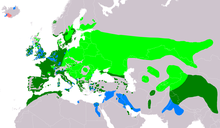Water rail
| Water rail | ||||||||||
|---|---|---|---|---|---|---|---|---|---|---|

Water rail ( Rallus aquaticus ) |
||||||||||
| Systematics | ||||||||||
|
||||||||||
| Scientific name | ||||||||||
| Rallus aquaticus | ||||||||||
| Linnaeus , 1758 |
The water rail ( Rallus aquaticus ) is a species of bird from the family of railing birds (Rallidae). It is a breeding and summer bird in all of Central Europe and partly an annual bird.
A total of four subspecies are described.
description
The 25 to 30 cm large water rail weighs around 100 to 190 g and has a wingspan of 40 to 45 cm.
The water rail has a short tail and a slightly downward-curved, reddish beak. The sides of the head, throat, neck and chest are slate gray to gray-blue. The eyes are reddish and the medium-length legs with the rather long toes are colored flesh-colored. The plumage on the abdomen, chest and face is light blue. The back is marked dark brown with black stripes. There is a black and white pattern on the sides. Males and females have the same coloration.
The chicks are generally black and have a light-colored bill. The call sounds like "kruieh" and is reminiscent of the utterance of a piglet .
Distribution and existence
The water rail lives in North Africa , in almost all of Europe (except North Scandinavia ) and in Asia . There are larger distribution gaps in the highlands of Central Asia. In Central Europe, it is a widespread breeding bird in wetlands from the lowlands to low mountain ranges. In the northern Alps it still occurs at altitudes of up to 1,400 meters. Important distribution areas in the transition from the lowlands to the low mountain range are Lippeauen and Emscherland .
The nominate form Rallus aquaticus aquaticus occurs in Europe as far as Western Siberia. The subspecies R. a. hibernicus occurs in Iceland, the subspecies R. a. korejewi is native to Central Asia and the subspecies R. a. indicus lives in East Asia.
The total European population is estimated at 140,000 to 360,000 breeding pairs. Holdings with more than 10,000 breeding pairs include Belarus, France, Germany, Hungary, Poland, Russia, Spain, Turkey and the Ukraine. In Central Europe there are between 36,000 and 69,000 breeding pairs. Very little knowledge is available about the development of the population. What is certain is that there are stock fluctuations after bad breeding years, for example as a result of long dry periods or floods. However, there were losses and declines in area after the 1950s when extensive reed areas were lost. The strong declines at Lake Constance were mainly due to very severe winters and extreme changes in water level during the breeding season. Overall, however, the stock is considered stable.
habitat
The shy water rail feels particularly at home in floodplains and swamp areas . It prefers very humid areas with a lot of reeds and a very dense environment. In addition, sedge bogs, alder forests and willow thickets as well as flooded meadows, swamp horsetail and water swaths are essential habitats for this species. It is essential that the birds can walk between the vegetation and that there are small open water areas. Accordingly, it also lives in small bodies of water or in narrow strips of reed, provided that there is sufficient cover. An example of a habitat in Germany is the Zwillbrocker Venn in the border area with the Netherlands. Since the water rail lives extremely hidden, it is above all the calls that reveal their presence.
In winter, some water rails move to southern and western Europe . It is generally a standing and line bird.
Way of life
Water rails are loners who defend their feeding grounds even in winter. Bird conservationists make use of this property to determine the population. The birds react very quickly to calls played from tape recordings.
The territories of the water rail cover an average of about 300 square meters; but can vary significantly in size depending on the habitat.
The water rail feeds on small fish , crustaceans , molluscs , insects and their larvae .

The breeding season extends from April to August. Both partners build a nest out of grass , stalks and other plant parts , which is very well hidden in the dense swamp vegetation. The female lays six to twelve eggs about 35 mm in size , which are warmed by both partners for three weeks until the chicks hatch. The young birds are precocial and fledge after seven to eight weeks.
Stock situation
The water rail is one of the endangered bird species. Just like the spotted mullet, which resembles it, it suffers in particular from the serious destruction of its habitat through drainage, dyke construction and the construction of natural banks.
supporting documents
literature
- Hans-Günther Bauer, Einhard Bezzel and Wolfgang Fiedler (eds.): The compendium of birds in Central Europe: Everything about biology, endangerment and protection. Volume 1: Nonpasseriformes - non-sparrow birds. Aula-Verlag Wiebelsheim, Wiesbaden 2005, ISBN 3-89104-647-2 .
Web links
- Rallus aquaticus in the endangered Red List species the IUCN 2008. Posted by: BirdLife International, 2004. Retrieved on January 25 of 2009.
- Videos, photos and sound recordings for Rallus aquaticus in the Internet Bird Collection
- Entry at the Swiss Ornithological Institute
- Age and gender characteristics of J. Blasco-Zumeta and G.-M. Heinze (English, PDF, 5.2 MB)
- Feathers of the water rail
Single receipts
- ↑ Bauer et al., P. 390
- ^ Nordrhein-Westfälische Ornithologengesellschaft (NWO) eV: The breeding birds of North Rhine-Westphalia. Water rail ('Rallus aquaticus'), brood distribution 2005–2009. Retrieved October 26, 2014 .
- ↑ Bauer et al., P. 390
- ↑ Bauer et al., P. 391




